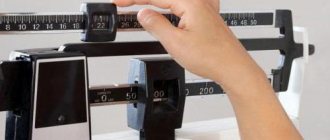Can the stomach stretch?
The stomach is a muscular organ. The average length of a developed stomach is 25 cm in length and 13 cm in height. In moments of acute starvation, it shrinks to 19 and 7 cm, respectively. The shape of the stomach is also subject to changes. It depends on the characteristics of a person’s physique: for overweight people it looks like a horn, for slender people it looks like an elongated stocking, for people with average parameters it has a hook-shaped shape.
Eating large amounts of food causes stretching of the stomach walls.
In parallel with the growth and maturation of a person, his stomach also grows: in a newborn baby, its volume is only 30 ml. By the first month of life, this figure increases to 100 ml. In six months - up to 250 ml. And finally, the average volume of this organ in an adult is 500 ml in the “hungry” mode.
The size of the stomach is variable. And not only the above factors influence it. Depending on the amount of food taken, its capacity can vary from 1-4 liters. In the absence of a person’s sense of proportion and control over the process of eating, over time the stomach muscles lose their tone, stretch, and gradually, in order to be satiated, the person has to increase the amount of food served.
How to reduce stomach volume with exercise
In order to reduce the volume of the main organ of the digestive system, it is necessary to do special exercises. They allow you to increase its tone.
How to reduce stomach volume? To do this, it is recommended to perform the following exercises:
- Belly breathing. This type of breathing helps to reduce the size of the stomach. The exercise must be performed on an empty stomach. Initially, perform 10 exercises, gradually increasing their number to 100. Correct breathing is as follows: take a deep breath of air and then exhale it slowly.
- Exercise "Vacuum". It is widespread in yoga asanas. Helps reduce abdominal volume.
This exercise should be performed as follows:
- take a “standing” or “lotus” position;
- take a deep breath and stick out your stomach;
- hold your breath and tighten your abdominal muscles;
- repeat the exercise at least 10-15 times.
With constant practice, you can not only shrink your stomach, but also get rid of several centimeters in the abdominal area.
Causes of stomach distension
The main reason for stretching the stomach muscles is considered to be an irresponsible approach to organizing your diet - increased portions of food, frequent snacking, a love of foods that are difficult to digest. The consequence of this is the appearance of extra pounds.
According to statistics from the Russian Association of Gastroenterologists, about 90% of obese people have a stomach the size of which is comparable to a similar organ in cattle.
But in addition to poor nutrition, its size is also influenced by factors such as:
- chronic fatigue;
- the presence of inflammatory diseases;
- the body being in a state of stress.
Thus, in a person experiencing nervous tension or periodic fatigue, certain receptors that control the feeling of satiety fail. Most diseases are characterized by the presence of inflammatory processes that inhibit the process of digestion of food - it lingers in the walls of the stomach, not reaching the intestines in time. As a result, the patient, instead of the prescribed five daily meals, eats an increased amount in 1-2 meals, stretching the walls of his own stomach.
Adjust your diet and portion sizes
Make it a habit to eat 5-6 times a day, but in small portions. Small meals are your best ally in reducing stomach size. There should be 3-4 hours between meals. Is it difficult to maintain such an interval? Don't forget that there are also light, balanced snacks that will dull your appetite before main meals and help you eat less.
Also, stick to recommended servings and don't overfill yourself. If you think you're not eating enough, start weighing your food and see what a 100, 200, 300 gram portion actually looks like (believe me, you'll be shocked).
Does water stretch the stomach?
Many of us are accustomed to hearing about the need to drink 1.5-2 liters of water a day, without going into the details of these recommendations. There are widespread concerns that such volumes contribute to stretching of the stomach walls. This is nothing more than a myth. Water does not stay in the body for a long time, passing through it in transit, and it is needed only for metabolism.
Drinking large amounts of water does not affect the size of the stomach.
In addition, each body is individual; there are simply no universal norms for fluid intake. It all depends on metabolic processes, the pace of physical activity, the surrounding climate, hormonal levels, the state of the gastrointestinal tract and the amount of food taken. Water is needed to dissolve and flush the foods you eat from your body. The more we eat, the more water the body requires. Accordingly, food stretches the stomach, not water. After regulating the eating regimen, the drinking regimen is inevitably adjusted.
About food and nerves
It is very important to know that disorders of the nervous system can nullify all attempts to improve the situation for the better. The fight against obesity and underweight is often related to the nature of people:
- Cholerics
. Too active, it is very difficult for such people to gain weight. They are very impulsive and irritable, neglecting nutrition. Thin people are more common among choleric people. - Melancholic people
. They are also predisposed to thinness, but due to a weak nervous system. They often become depressed and dependent on external factors. - Sanguines
. As a rule, they are more inclined towards a strong body and only illness can prevent them. - Phlegmatic people
. They are located more towards fullness, the nerves are balanced, and in physiology there is often a slowdown in metabolism.
But you shouldn’t think that your characteristic type determines everything. A person must ask himself a simple question, what should he eat to gain weight, and find answers to it. Everyone has the power to overcome their weaknesses and do what is best for themselves.
Video: products for weight gain
Today, when many are concerned about the issue of weight loss, there are people who find it difficult to gain weight. As a rule, the issue of weight gain in a short period of time is often of interest to thin guys and girls, i.e. adolescents, who burn calories most actively at this age.
Meanwhile, gain weight in a week
not so difficult, and depends on how much weight gain you are trying to achieve. Try to include high-calorie foods in your diet, which is also important for health, because... your diet should consist of healthy foods. To gain 1-2 kg. per week, you must pay close attention to your diet and do not skip meals.
Characteristic signs
Stomach distension is accompanied by severe symptoms, which become quite difficult to ignore as the disease progresses. The first signs of the disease include:
- feeling of heaviness;
- pain in the epigastric region;
- nausea and vomiting;
If these symptoms are detected once, it is recommended to massage the abdominal area with gentle clockwise movements. As a preventive measure, you can take drugs that improve fermentation.
If the situation recurs periodically, it is better to consult a doctor for a diagnostic examination. The size of the stomach can be determined using gastroscopy, fluoroscopy or computed tomography.
Reversibility of the process and methods of correction
A distended stomach is not a death sentence. You can return it to normal physiological sizes using radical or natural methods. The first are surgical interventions. The second involves performing special physical exercises and correcting nutrition.
Surgical methods
Gastric resection
Resection using the Billroth method.
Resection is the removal of part of the stomach by excision. Today, this technique is considered outdated, but is still valid in some hospitals. In essence, it is a cavity surgical intervention, which rarely goes unnoticed for the patient. During the operation itself, you can lose a lot of blood. Upon completion, a number of unpleasant “surprises” may also arise: the risk of internal bleeding, the likelihood of dehiscence and suppuration of the sutures, complications in the form of impaired digestive function, pancreatitis, etc. Read more about gastric resection here.
Bandaging
Banding is a correction of the size of an organ by applying a “blockade” in the form of a restrictive ring to part of it. The digestive organ is divided into two chambers: the upper, smaller one, is quickly filled with food, as a result of which the brain quickly receives a signal of saturation. Then food from this chamber moves to the lower one, where it is digested. This method also involves abdominal surgery with all its disadvantages. In addition, the patient may experience difficulty passing food through the ring area and the development of gastritis and peptic ulcers.
Gastroplasty
Vertical gastroplasty is a complex manipulation in which the upper part of the organ is transformed into a continuation of the esophagus. This is done for the same purpose as with banding (an accelerated feeling of satiety), but it also has the same disadvantages.
Ballooning
Ballooning is an endoscopic surgical method that involves inserting a balloon filled with liquid into the stomach. If you delve into the essence of the operation, it becomes clear that the size of the stomach does not decrease with this method. The container simply takes up a certain amount of space intended for food. The probable consequences of ballooning are quite serious: the risk of pressure sores of the walls of the operated organ and the closure of the exit to the duodenum.
Natural Methods
Special gymnastics
A few simple physical exercises borrowed from yoga will help work the diaphragm and strengthen all the muscles of the body:
- Breathing while lying down. It is necessary to lie down on a hard horizontal surface and slowly take a deep breath, carefully drawing in the anterior abdominal wall below the ribs. Then also slowly exhale. And so on for at least 10 approaches, each time trying to draw in the stomach more strongly.
- "Breath of a Dog" Starting position – half lotus position, back straight. Next, inhale three times through the nose, then exhale three times - as animals do when running.
- "Cup". Lying on your back, you need to alternately inhale and exhale, arching your body so that the retracted stomach resembles the shape of a bowl. In this case, your hands should be kept behind your head. For the first time, 4-6 times will be enough; in the future, the number of approaches can be increased.
Regular running, race walking, oriental belly dancing and jumping rope will also benefit.
Diet correction
Small meals, mandatory breakfast, consumption of foods rich in fiber (cabbage, carrots, beans, spinach, cereals, lentils, apples, bananas), minimizing salt and spices, avoiding sour, fatty foods and alcohol. Consume fruit in small portions at least half an hour before meals. Chewing food slowly.
It is not recommended to eat too hot foods and you should avoid combining food with drinks. It will be much healthier to drink a glass of water 30 minutes before or after a meal.
"The Five Spoon Rule"
In the course of practical work with patients, nutritionists were able to determine the ideal size of a single portion of food, which stimulates the return of the stomach to normal size.
5 tablespoons or 150 g of food - just enough to eat so that the stomach gradually shrinks to the required parameters.
This is enough to satisfy the feeling of hunger and replenish the body’s energy reserves. To achieve a lasting effect, it is recommended to maintain an interval between meals of at least three hours. This approach allows you to return your stomach to its previous size in 3-6 months and tighten your figure.
With the help of a surgeon’s hands, you can quickly achieve your goal, but you must remember that any operation is always a risk for the body’s condition, a certain time for its rehabilitation and the possibility of irreversible consequences. The natural approach to reducing gastric volume requires a lot of time and developed willpower, but allows you to avoid negative results. Which option to choose is up to each person to decide individually.
How to reduce stomach volume at home?
Do not rush to sound the alarm when you hear that in order to lose weight, you absolutely need to reduce this organ for digesting food. Fortunately, this procedure does not require the intervention of a surgeon. Next, we will tell you how you can reduce your stomach without surgery.
can reduce your stomach in order to eat less and lose weight as follows:
- follow a diet, refusing food that promotes stretching of the organ - fatty, smoked, fried;
- After eating, under no circumstances should you immediately drink it with water;
- there should be three meals a day, in small portions;
- eat only when you really want to;
- never skip breakfast;
- minimize, or even better, completely abandon dry food; dried fruits and low-fat kefir are acceptable as snacks;
- drink 1.5 to 2 liters of purified still water daily;
- Replace sweets and other high-calorie junk foods before bed with low-fat cottage cheese with a glass of warm milk.
When you feel a strong feeling of hunger , cook your favorite porridge. Then put 150 grams of the product on a plate and eat it all with a teaspoon. You should eat slowly, in a calm environment. Chew food thoroughly until liquid before swallowing. Try not to be distracted by anything during this time in order to fully enjoy the taste of the porridge.
Also, folk remedies: decoctions of parsley, celery and burdock root will serve as a kind of diet to reduce appetite and, accordingly, the stomach.
Ways to Shrink Your Stomach with Exercise
Few people know, but in order to succeed in reducing the size of the stomach in a short time, you need to engage in physical exercise. We will tell you further what activities will help in this difficult task.
So, the most effective ways to reduce the size of the stomach are the following exercises:
- Lie on the floor, trying to keep your shoulder blades close to it. The back should be straight. As you inhale, draw in your stomach as much as possible and hold in this position for 10-15 seconds. As you exhale, relax;
- Stand up straight. Straighten your back. Draw in your stomach as you inhale, and as you exhale, relax. The essence of the exercise is fast, rapid breathing, 15 inhalations and exhalations. It is recommended to perform 5 repetitions of this exercise per day;
- Get on your knees with your hands on the floor. While in this position, tighten your buttocks and tighten your abdominal muscles. Take 10-15 sharp breaths;
- Take a lying position. Bend your legs at the knees and inhale as much air as possible into your lungs. Then exhale and tense your stomach. Raise your body so that your shoulders are directed towards your knees.
Proper diet
In addition to exercise, there is a special diet to shrink your stomach and thereby lose weight. It is usually calculated for a month. Let's look at what its basic principles are:
- first of all, you need to give up smoked, salty, sweet and fatty foods;
- you can eat grain bread;
- potatoes are permissible only baked and, of course, in moderation;
- Only red wine is allowed among alcoholic beverages;
- The maximum number of calories per day is 2000.
The first ten days of the diet are designed to cleanse the intestines. The approximate menu for the day is as follows:
- Breakfast: 200 ml low-fat natural yogurt;
- Lunch: zucchini and cabbage soup with grain bread;
- Dinner: buckwheat porridge and a glass of kefir.
From 10 to 20 the most strict diet is expected:
- fruit salad;
- broccoli soup;
- stewed pepper - 200 g.
The final stage of the diet to reduce appetite is designed to restore water-salt balance in the body. Also during this period there is a gradual transition to proper nutrition. The maximum calorie intake increases to 1500 per day:
- millet porridge with dried fruits;
- 250 g boiled perch;
- stewed zucchini, peppers, eggplants and tomatoes - 250 g, a glass of low-fat kefir.
Recommendations for saving the result
Exiting the diet to reduce stomach volume should be gradual. In order to avoid an increase in appetite, try to eat according to the above principle for as long as possible, gradually adding familiar low-calorie foods to your diet.
Also try to avoid stressful situations. After all, as you know, it is a bad mood and the constant tension that reigns around that makes a person eat his problems. High-calorie junk food, of course, will not improve the situation, but it can calm a person down for a while. This, in my own words, is where overeating begins.
Upon completion of the above diet to reduce the size of the stomach, try to get enough sleep, walk in the fresh air as often as possible and devote at least a little time to sports - this way you will definitely maintain the results obtained.
What should you be afraid of?
A distended stomach is not always as harmless as it seems. The danger is that this pathology can be a consequence of serious diseases, among which are often found:
- gastric hernia;
- polyps and tumors of the digestive system;
- gastropathy;
- pyloric stenosis;
- malignant neoplasms on the walls of the stomach - cancer.
Gastroenterologists deal with gastrointestinal problems. For preventive purposes, it would be a good idea to visit their office at least once a year. Timely diagnosis will help prevent many problems associated with the gastrointestinal tract, saving the patient’s nerves and money.
RepostTweet
How to shrink a distended stomach naturally at home
The human body is an amazing creation of nature. His ability to adapt is amazing. If you give properly dosed physical activity, the heart will pump more and more blood in order to save energy for itself, as well as to increase the saturation of the body with oxygen.
The stomach is no exception. It is easy to understand how to reduce a distended stomach at home. If smaller volumes of food enter its cavity, it will reduce its volume. Therefore, dietary nutrition is one of the logical ways to reduce the size of an organ. Of course, you will have to use willpower and follow the basic rules, and not everyone can do this.
In order to understand how to reduce a distended stomach, you must adhere to the following principles:
- The daily consumption of food products by weight should not exceed one and a half kilograms (scientists have proven that this mass is best digested, absorbed in the intestines, and does not stretch the walls of organs).
- Since ancient times, it has been customary that there is a first, second and third course, the last often being some kind of liquid. There is a paradox here: you should not wash down your main dishes with water or other liquid.
- It is not recommended to make a mixture of fresh fruits and staple foods. Fruits contain a large amount of dietary fiber, the fermentation process begins, resulting in the formation of a large amount of carbon dioxide, which easily expands the walls of the stomach.
- The liquid should be consumed twenty minutes before eating, and then 2 hours after the meal (together with small portions, this will reduce the secretion of digestive enzymes by the pancreas and gall bladder).
- Eating should last at least twenty minutes, during which time the brain receives information about satiety, and the person does not overeat. In this mode, food must be consumed, chewing it thoroughly.
- The diet should include well-known meals: breakfast, afternoon snack, lunch, snack, dinner. The portions at each meal should be halved; the stomach will begin to get used to such nutrition, thereby reducing the volume. The basic rule is little, but often! Doctors advise increasing the number of meals up to six times. Three full-fledged receptions, three additional ones - the best option. The weight of food taken should be no more than 200 grams. Snacks are designed to prevent a constant feeling of hunger throughout the day due to reduced portions. It is recommended to include vegetable or fruit salads in your snack diet, where you can add nuts and dairy products.
- Fatty, fried, smoked - exclude. The properties of this type of food do not stimulate stomach contraction, but have the opposite effect.
- The basis of the menu is protein dishes, as well as those containing a large amount of fiber. Protein foods are an optimal source of energy and help you feel full faster. It takes a lot of energy to break down proteins, which also plays into your hands. Dietary meat, fish products, dairy products, vegetable salads and stews, and soups are suitable.
- During meals there should be no distracting signals from outside (playing on the computer, watching TV, reading a book). Due to such errors, the signal that the body has already taken the right amount of food comes much later, which also contributes to overeating.
It has been experimentally determined that after two weeks of compliance with these rules, positive dynamics will already be visible. The answer to the question of how to reduce a distended stomach at home is very simple. The main thing is discipline and willpower.










